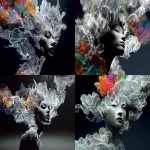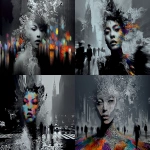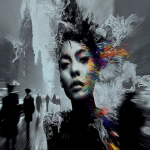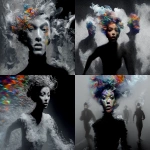Explore the Best AI Image Gallery

Beyond the Canvas: How Wearable Tech is Redefining Artistic Expression
For centuries, art has been confined to canvases, sculptures, and stages. But with the advent of wearable technology, the boundaries of artistic expression are being shattered, ushering in a new era of creative possibilities. This transformative technology, encompassing everything from smart glasses and augmented reality (AR) headsets to haptic feedback suits and motion-capture garments, is empowering artists to transcend traditional mediums and explore innovative ways to create, interact, and experience art.
A World of Interactive Art
Wearable tech allows artists to seamlessly integrate technology into their creations, giving viewers an immersive and interactive experience. Imagine stepping into a painting and becoming part of the artwork itself. AR glasses can superimpose digital elements onto the physical world, transforming everyday environments into dynamic art installations. Smart textiles embedded with LEDs or sensors can react to the viewers movements, creating responsive and captivating displays. Artists are also using haptic feedback suits to transmit tactile sensations, allowing viewers to literally feel the texture and weight of virtual objects.
New Tools for Artistic Expression
Beyond interactive experiences, wearable tech provides artists with a suite of powerful new tools to enhance their creative process. Motion-capture technology allows dancers and performers to translate their movements into digital data, which can then be used to create stunning animations or choreograph virtual performances. 3D scanners enable artists to capture the intricate details of real-world objects and translate them into digital models, fostering experimentation with hybrid creations that blend physical and virtual realms. Smart pens and drawing tablets offer intuitive ways to sketch, paint, and sculpt digitally, freeing artists from the constraints of traditional materials.
Ethical Considerations in a Wearable World
As with any groundbreaking technology, the integration of wearable tech into the creative industry raises important ethical considerations. Data privacy is paramount, ensuring that user data collected through wearables is handled responsibly and securely. Transparency about how data is used and obtained is crucial to build trust between artists, viewers, and technology developers. Furthermore, access to these technologies should be equitable, preventing a widening gap between those who can afford to utilize them and those who cannot.
The Future of Art: Wearable Tech at the Forefront
Looking ahead, the convergence of wearable tech and artistic expression holds immense potential. Imagine virtual reality (VR) environments where viewers can collaboratively create and explore artwork, or AI-powered wearables that assist artists in generating unique designs and concepts. As technology continues to evolve, we can expect even more groundbreaking applications that will redefine how we create, experience, and interact with art.






](https://images.ai-img.art/thumbnails/150/7cf5a08238f29c821f52bb4f63db48af0b7f633ff3b9f7253074d78ced9ff6f6.webp)


](https://images.ai-img.art/thumbnails/150/847809c77ca9a73b68bc190e6efb06fec87157685a243730d5a66a403b0e6e10.webp)

](https://images.ai-img.art/thumbnails/150/ff09e32d2be011c0dd785984c5c1e47839ce551a31da1bde242860b30df2aa30.webp)

](https://images.ai-img.art/thumbnails/150/a3ed6513a6661aa3ee46e0c2924d1e8888854e91d8908de39db5590dc41f8d8f.webp)




](https://images.ai-img.art/thumbnails/150/bd056a4718c27444e064198762f8dc8ffa1f74f1afd7dcda8d5cb8b142797d6e.webp)






](https://images.ai-img.art/thumbnails/150/2ebdeb4f7db35100e5be5de9bc3e533a40d14e5feedefd7ffc586524a0f3ba8c.webp)

















](https://images.ai-img.art/thumbnails/150/0ba0be922ab76af53f75ab90126ae2b18a600ee3b96941e8ab897a9f10594e5a.webp)


](https://images.ai-img.art/thumbnails/150/685ae68cfab93a7e59a71206867b060c45bd6fd3cd561c4fe60fca514b09c5f8.webp)


